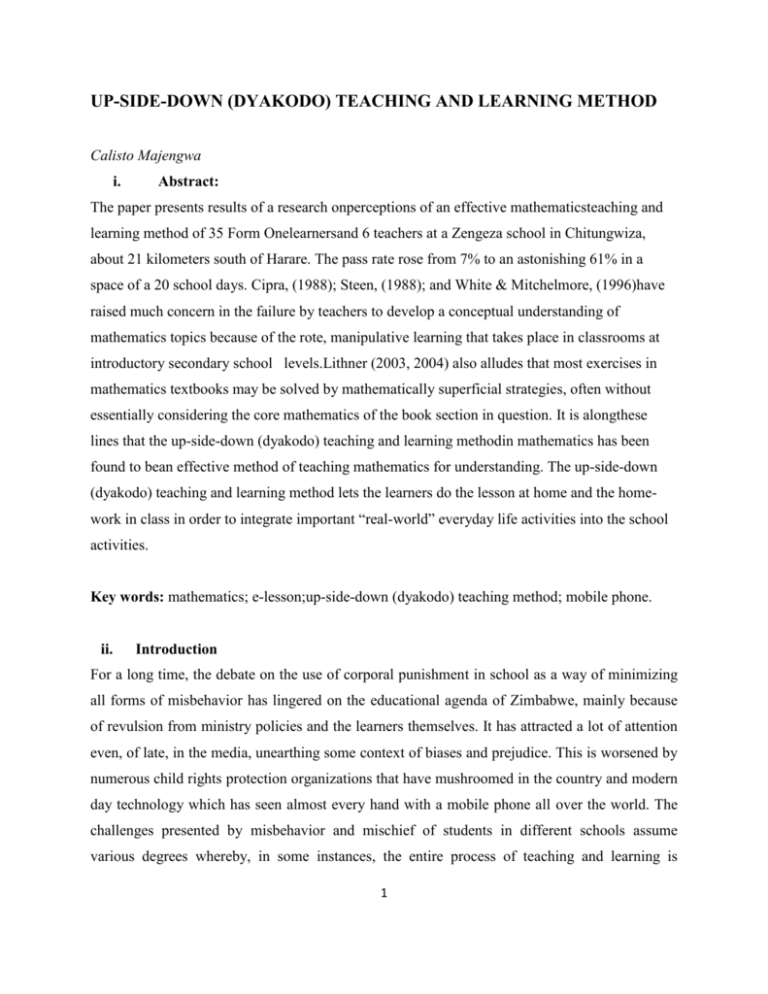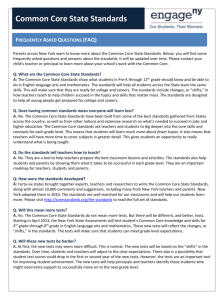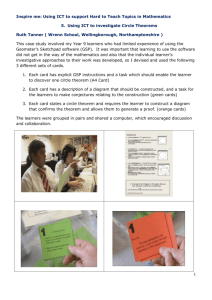(dyakodo) teaching and learning method in mathematics
advertisement

UP-SIDE-DOWN (DYAKODO) TEACHING AND LEARNING METHOD Calisto Majengwa i. Abstract: The paper presents results of a research onperceptions of an effective mathematicsteaching and learning method of 35 Form Onelearnersand 6 teachers at a Zengeza school in Chitungwiza, about 21 kilometers south of Harare. The pass rate rose from 7% to an astonishing 61% in a space of a 20 school days. Cipra, (1988); Steen, (1988); and White & Mitchelmore, (1996)have raised much concern in the failure by teachers to develop a conceptual understanding of mathematics topics because of the rote, manipulative learning that takes place in classrooms at introductory secondary school levels.Lithner (2003, 2004) also alludes that most exercises in mathematics textbooks may be solved by mathematically superficial strategies, often without essentially considering the core mathematics of the book section in question. It is alongthese lines that the up-side-down (dyakodo) teaching and learning methodin mathematics has been found to bean effective method of teaching mathematics for understanding. The up-side-down (dyakodo) teaching and learning method lets the learners do the lesson at home and the homework in class in order to integrate important “real-world” everyday life activities into the school activities. Key words: mathematics; e-lesson;up-side-down (dyakodo) teaching method; mobile phone. ii. Introduction For a long time, the debate on the use of corporal punishment in school as a way of minimizing all forms of misbehavior has lingered on the educational agenda of Zimbabwe, mainly because of revulsion from ministry policies and the learners themselves. It has attracted a lot of attention even, of late, in the media, unearthing some context of biases and prejudice. This is worsened by numerous child rights protection organizations that have mushroomed in the country and modern day technology which has seen almost every hand with a mobile phone all over the world. The challenges presented by misbehavior and mischief of students in different schools assume various degrees whereby, in some instances, the entire process of teaching and learning is 1 disrupted(Monk and Dillon, 1995). Something has to be done to bring sanity back into our classrooms and education system as a whole using modern technology since according to Allen and Seaman (2010), the continued growth of online education cannot be overstated as eeducation is here to stay. iii. Research problem (background and motivation) Mischief in schools has become rampant nowadays and is mainly mobile phone-related. The researcher decided to turn the situation around using the culprit gadget to motivate learners in their classroom activities. The researcher has observed that schools do not permit learners to bring mobile phones into the school premises, let alone the classroom. However, try as school authorities might, almost on a daily basis, learners stillbringthesegadgetstoschool and disrupt school activities. The situation could be changed: this point of view provokes the beginning of this research. The goals of the research were: (1) To find an appropriate effective mathematics teaching and learning method that ensures maximum learner-participation. (2) To come-up with phone-based learning that enhances achievement in mathematics teaching and learning. iv. Related Studies/Literature review Mathematics is not very popular in secondary schools; mathematics is difficult (Holubova, 2008). The mathematics pass rate in this particular school left a lot to be desired, hence the need to find if something could not be done regards the teaching methods since in other subjects the situation was not the same. A lot of research has been carried-out on how to teach mathematics for understanding (de Villiers, 2012) thus the aim of this study was to find effective mathematics teaching methods and take advantage of what is available to make learning more interesting and motivational for those who find the subject difficult. According to Holubova (2008, p.27) the education system nowadays “is characterized by a gap between how students live and what they 2 learn and how they learn”. The researcher decided to find if mobile phone could not be used as an effective medium of instruction instead. v. Methods of research Methods of our research were: homework, e-learning lessons, and revision exercise. The teacher made some e-lessons and sent them to the learners’ smart mobilephones (different types), one at a time. The learners then went through the lessons at home and came and did the homework in class; what had to be done in class was done at home and what had to be done at home was done in class! The study was based on the topic of mensuration. The initial introductory lessons on the topic had produced a merger 7% pass rate in a written revision exercise. It was at this juncture that the researcher, after consultations with the subject teacher, introduced the up-sidedown (dyakodo) teaching and learning method. The learners were asked to bring their mobile smart phones to school. This drew a lot of excitement even though they had been told that they were going to use them for learning purposes only. The lessons were crafted using a computer and sent one by one to the 35 Form One learners’ smart mobile phones via Bluetooth. The learners would then go through the lessons in the comfort of their homes. In class they would then do the home-work. The exercise was carried-out continually for 5 school days, some interviews, and lesson observations were carried-out before a revision exercise was given. Interviews, Lesson observations, Revision exercise,conclusions and recommendations Interview questions The interview was carried-out after all the lessons had been done, right at the end of the study. Question 1: How did you find learning mathematics using your mobile phone as compared to conventional learning? Most of the learners(31)found it fun and exciting to learn using their mobile phones. The lessons were clear and easy to follow. They also concurred on the fact that they could go through the lessons at their own pace and had room to repeat points they were in doubt with as much as they could. However, there are some learners (3) who had found the lessons difficult to follow no 3 matter how many times they tried to re-visit them. One learner indicated having power problems with the mobile phone at home and could not make any progress alone. Question 2: How did you find learning mathematics in the comfort of your home as compared to classroom learning? In our schools the chalk talk method is used most often. In particular, in mathematics “practice makes perfect” is quite common. This type is not very different from rote-learning type where the learner will end-up knowing “how to get the answer” and not “why”. Most learners (32) were impressed by the opportunity such type of learning gives to parents and the entire family to participate in their learning rather than the ‘practice’ dossier given in class. They found it easier to relate what they learn in mathematics to their everyday life; examples were readily available. Some learners (2) did not find it easy as family members were not willing to assist. Question 3: How do you find mathematics home-work done in class as compared to that done at home? Most learners found the home-work easy and fun. They admitted that they had understood the concepts very well and found the exercise more or less like revision. The time taken doing it was not much such that a lot of time was spent discussing concepts and trying to derive meaning from grey areas. Question 4: What type of effect has this teaching and learning method had on your learners? This question was responded to by the mathematics head of department and 4 mathematics teachers and one Shona teacher. They all concurred that the method was a lot less timeconsuming and gave the learners a chance to make meaning of concepts at their own pace. Their level of understanding was elevated as evidenced by their participation during the home-work and revision exercises. The revision exercise produced a 61% pass rate! 4 Lesson observation A class of 35, the Mathematics head of department, three mathematics teachers and one Shona teacher took part and the researcher took part in all the five lesson observations. Even though all the five lessons were done via mobile smart phones, only one is attached below which serves as an example. The aim of the outcome of the research was to motivate learners in the teaching and learning of mathematics tohelp them link home with classroom. The teacher started by summarizing the lesson which the learners had done at home before embarking into the homework which the learners were not aware of. Somefeedback,assessment and professional development opportunities were availed to them. Lesson (done at home using mobile smart phones): CLASS:1D TOPIC: Mensuration DATE: Monday 20 January 2014 TIME: 7:15- 7:55 am LESSON OBJECTIVES: - To ascertain that learners understand the true meaning of SI units - To give learners a chance to derive their own meaning from concepts - To allow learners work at their own pace LESSON PRESENTATION: How large is a millimeter? The widthof a pin How large is a centimeter? The widthof the topof your finger 5 How large is a meter? About the widthof one & 1/2 doors 1 meter There are 100 centimetres in 1 metre, when we change cm to m we divide by 100. Remember! When divide by 100 the units move two places to the right. This is how we change 427cm to metres H T U th hth tth 4 7 0 0 2 0 Divided by 100 Therefore 427cm = 4,27m To change from metres to centimetres we multiply by 100; when we multiply by 100 we move each digit two places to the left. This is how we change 3,51 m to cm H T U th hth Tth 3 5 1 Therefore 3,51m = 351cm 6 Examples: 1. Converting centimetres to metres 354cm 3.54m 15.4cm 0.154m 779cm 7.79m 52.4cm 0.524m ÷100 939cm 9.39m 395cm 3.95m 25.8cm 0. 25 8 m 2. Changing measurements in metres into centimetres 5.4m 540cm 6.2m 620cm 12.7m 1270c m 3m 300cm x100 7.6m 760cm 0.54m 54cm 0.3m 30cm 7 PUPIL ASSESSMENT EXERCISES (Done at home): Metric Units 1 Kilometer (km) = 1000 meters 1 Meter = 100 Centimeters (cm) 1 Meter = 1000 Millimeters (mm) Which one is larger? A. 1 meter or 105 centimetres B. 4 kilometers or 4400 metres C. 12 centimeters or 102 millimetres D. 1200 millimeters or 1 metre E. What is the length of the line in centimetres? _________ cm What is the length of the line in millimetres? _________ mm Summary or conclusion: Other types of measurements Volume is the amount of space an object takes up. The base unit of volume in the metric system in the litre and is represented by L or l. Standard: 1 liter is equal to one cubic decimetre 8 We usegraduated cylinders to find the volume of liquids and other objects. We usetriple-beam balances to find the mass of various objects. The objects are placed on the scale and then you move the weights on the beams until you get the lines on the right-side of the scale to match up. Metric Units 1 Kilogram (km) = 1000 Grams (g) 1 Gram (g) = 1000 Milligrams (mg) PUPIL ASSESSMENT: 9 Homework(Done in class): 1. What is the volume of water in each cylinder? A B C 2. Which is larger? A. 1 kilogram or 1500 grams B. 1200 milligrams or 1 gram C. 12 milligrams or 12 kilograms D. 4 kilograms or 4500 grams vi. Results and discussion There are a lot of advantages and disadvantages of up-side-down (dyakodo) teaching and learning method. Our finding is that teaching and learning using what learners like most moves lesson delivery from whole-class to personalized instruction, from lecture and recitation to discovery. It invokes constructive discussion with a cooperative social structure. All students learn the same thing in different ways and different students learn different things at the same time. The lesson activities are done outside the classroom environment thus reducing the gap between school and home. Up-side-down (dyakodo) teaching method leads to team10 work;learners learn to work independently but with the same goal. When home-work is done in class learnerswill have a chance to be innovativein their work. When learners do the actual lesson at home, they have more time to go through it and have a chance to replay parts they would not have understood.It also gives studentsfreedom to generate artifacts which is critical to their construction of knowledge and can serve to bridge the gap betweenphenomena in the classroom and real-life experiencesat home that can lead to the introduction and use of local languages in the teaching and learning fraternity.Parents and relatives at home are also given a chance to make direct contributions in the teaching and learning of the subject. We found some disadvantagestoo—some learners are not able and willing to do anything without close supervision and monitoring. Some teachers prefer ‘privacy’ when it comes to things they say when they teach so they are not prepared to video-record their lessons. vii. Recommendations To incorporate the up-side-down (dyakodo) teaching and learning method into our classrooms, the following should be conducted by all stakeholders; Ministry of Primary and Secondary Education, Teachers’ Training Colleges, Universities and Schools: (1) Seminars; (2) Task-focused teaching methods; (3) Observation in schools; (4) Micro-teaching. We should focus on motivating the learners in mathematics and science. For the motivation it is necessary: (1) Good understanding of the problem; (2) The school closer to the practical life; (3) Video-recorded lessons; 11 (4) Simple language; We should analyzemethods—up-side-down (dyakodo) teaching and learning method, game-based, problem-based learning, project-based learning, e-learning techniques, and motivation by adventure inpedagogy, computer-based instruction and experiments. Mobile phone-based teaching and learning can be a part of our motivation activities. In particular, mathematics is irreplaceable for the development of our nation because modern technology involves mathematics. Learning mathematics leads to the development of thinking skills and understanding other sciences since it is the basis for all types of analytical and measuring systems. viii. Conclusion This study sought to explore ways of minimizing misbehavior in the classroom without using force, which is in this case corporal punishment. Preferred ways of dealing with it seem to ignore taking the lessons into the thick of things, using what the learners enjoy most, to deliver lessons. Lack of commitment on the part authorities and lack of innovativeness by educators could be fueling misbehavior in the educational arena with everyone still relying on corporal punishment to serve the situation. As a developing country, we are exposed to new trends and causes of misbehavior so there should be modern ways to deal with them that we have to collectively come up with. ix. References 12 Allen, I. E., & Seaman, J. (2010). Class differences: Online education in the United States, 2010. Babson Survey Research Group. Blumenfeld, P. C., Soloway, E., Marx, R. W., Krajcik, J. S., Guzdial, M. & Palincsar, A. (1991). Motivating project-based learning:Sustaining the doing, supporting the learning. Educational Psychologist, 26 (3-4), 369-398. Chiappetta, E. L. & Adams, A. D. (2004). Inquiry-based instruction: Understanding how content and process go hand-in-hand withschool science. The Science Teacher, 71(2), 46-50. Cipra, B. A., (1988). Calculus: Crisis Looms in Mathematics' Future, Science, 239 1491-1492 Colley, K. E. (2005). Project-based science instruction: Teaching science for understanding. Radical Pedagogy, 7(2). de Villiers, M. (2012). Some reflections on the Van Hiele theory. National Mathematical Congress in Namiba (pp. 1-35). Swakopmund: National Mathematical Congress in Namiba. Gless-Newsome, J. & Lederman, N. G.. (2002). Examining pedagogical content knowledge. Dordrecht: Kluwer Academic Publishers. Holubova, R. (2008). Effective teaching methods. US-China Eduucational review , 27-36. Holubova, R. (2007). The innovation of physics teacher training at the Palacky University: Physics teacher in the Czech Republic.The International Journal of Learning, 14(2), 41-46. Lithner, J. (2003). Students’ mathematical reasoning in university textbook exercises. Educational Studies in Mathematics, 52, 29–55. 13 Lithner, J. (2004). Mathematical reasoning in calculus textbook exercises. The Journal of Mathematical Behavior, 23(4), 405-427. Monk, M. & Dillon, J. (1995). Learning to teach science. London: Falmer Press. Steen, L., (Ed.) (1988). Calculus for a New Century. Washington, DC: Mathematical Association of America. White, P., & Mitchelmore, M. (1996). Conceptual Knowledge in Introductory Calculus, Journal for Research in Mathematics Education, 27 (1) 79-95. 14








